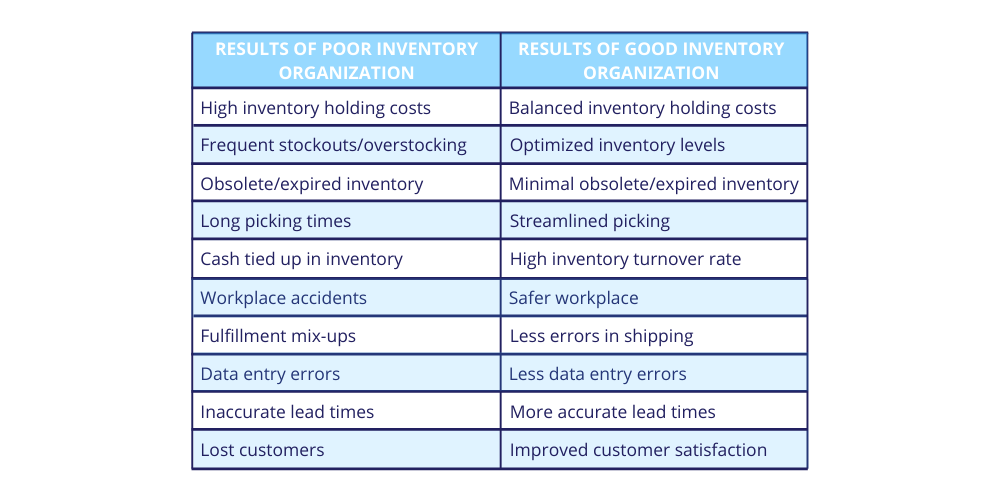Warehouse Organization: How to Set Up a Smooth-Running Warehouse
Good warehouse organization is key to keeping your inventory processes running smoothly. Here is how to implement warehouse organization best practices.

You can also listen to this article:
Why is Warehouse Organization important?
For new small manufacturing companies and craftspeople that produce bespoke items in low volumes, warehouse organization is almost never a great concern. These types of businesses rarely keep more materials in stock than is needed to fulfill their current orders. Not to mention the Work-in-Process and finished goods inventories that are always held at a minimum.
As a business grows, however, so does its inventory. And while a small, unorganized stockroom at the back of the workshop could be sufficient when production volumes are low, it might be a good idea to expand inventory space before you actually need it. What you must do in any case, though, is to keep your warehouse spaces neatly organized.
Good warehouse organization practices are not only about knowing where you can find each of your Stock Keeping Units. They are also a prerequisite for safety, speed, cost-effectiveness, and ultimately, customer satisfaction.
Sadly, warehouse organization is not something that only starting businesses need to learn. There are many manufacturers and distributors out there that lose money and risk their employees’ health and safety by continuing to use poor warehouse organization practices.

Warehouse setup basics
Setting up a warehouse is not an easy task by a long shot. It involves a lot of work and logical thinking. The main question here is how to ensure a good flow of materials through the key areas of the warehouse.
The key areas are:
1. Loading dock
The loading dock is the entrance and the exit for stock items. If possible, it is advisable to separate the dock into two: an area for loading outgoing shipments and an area for unloading incoming ones. This way, incoming goods will never become an obstacle to shipping out merchandise to your customers.
2. Reception
Right at the unloading dock should be the reception area where goods are accounted for, unpacked, labeled, and prepared for storage.
3. Storage
Storage is the main area of a warehouse where goods are kept. In the case of manufacturers, there are separate storage areas for three different inventory types: raw materials, Work-in-Process, and finished goods inventories.
4. Picking
The picking area is sort of an intermediary between storage and packing or production. Necessary items are gathered from the storage area and brought to the picking area for a swifter transfer. If you manufacture, make sure that you keep separate areas for picking for shipping and picking for production.
5. Packing and Dispatch
This area is for preparing merchandise for shipment, i.e. packing and properly labeling the products before they are shipped out to the customer. Make sure to leave ample space for these activities.
(6.) Service areas
These are areas that are not directly related to handling goods but are essential for doing business nevertheless. These include office spaces, break areas, washrooms, kitchens, etc.
Warehouse layout tips
Some of the golden rules for designing a warehouse layout are:
- Create a detailed map for drawing the layout. Include everything from shelves and racks to doors, windows, and support columns.
- Keep the areas for incoming and outgoing goods separate.
- Utilize both horizontal and vertical space to the fullest.
- Give plenty of room for the reception of goods to ensure efficient sorting and inspection.
- Keep raw materials and WIP inventories closer to the production floor.
- Keep the finished goods inventory area closer to packing and dispatch.
- Store goods that are often used together close to each other.
- Keep faster-moving goods closer and lower, and slower moving goods farther and higher.
- Make sure there is ample room for people, trolleys, pallet jacks, and forklifts to move freely.
- Make sure that there is ample lighting in every spot.
Warehouse Organization best practices
When you have designed the perfect layout for your warehouse, next you will need to start organizing your inventory. Here are the warehouse organization best practices to follow if you want to ensure smooth workflows, maximum efficiency, and full product traceability.
1. Mark the areas
The first thing to do would be to use signs, paint, and tape to create visual indicators in the warehouse. These markings create pathways for traffic, divide spaces, outline workstations and storage locations, and convey safety information.
For example, you can use different color floor tape to allocate spaces to different types of goods, indicate hazardous areas or the location of safety equipment, or divide corridors for forklifts and pedestrians. By using these simple visual cues, you can drastically improve efficiency as well as workplace safety.

2. Create a code system for your SKUs
SKUs or Stock Keeping Units are codes that represent distinct inventory items and allow for inventory tracking. Two different SKUs always represent different products, even with minor variations symbolizing attributes such as color, size, weight, material, etc. For example, if you sell three different size tables made of three different types of wood, then each combination of the characteristics should have its own SKU. Likewise, the distinct types of raw materials (e.g. maple, oak, and walnut boards) should have their own SKU code each.
SKUs are a prerequisite for efficient inventory tracking. While the same types of materials coming in from different suppliers or the same items sold in different channels might have different product titles or descriptions, these identical items should still share the same SKU code. This allows you to account for the goods throughout the business without having to put together numbers across different areas.
Read more about Stock Keeping Unit (SKU) Best Practices.
3. Label everything
After creating an SKU system, use the codes to create labels for your inventory items. Be sure to attach the tags so that when the items are put onto the shelves, the label remains clearly visible. This way, you will make sure that everything is where it should be. And even if various goods in your inventory look similar, there is little chance to mistake them when proper labeling practices have been implemented.
Apart from the goods in your inventory, you can label everything else: aisles, racks, shelves, bins, workstations, and equipment. This would further improve organization in the warehouse, indicating that everything has its proper place and minimizing search time as a consequence.
4. Document every movement
Each inventory movement needs to be documented for accounting purposes and to ingrain traceability in the company. Receiving a shipment from your supplier? Document it. Transferring raw materials into production? Document it. Transferring Work in Process into WIP inventory? Document it. Shipping finished goods out to the customer? Definitely document it.
Documenting everything that happens with your inventory will allow you to:
- keep meticulous financial records
- know where each and every part of your inventory is and has been
- track down and eliminate inventory-related product nonconformity (e.g. due to a batch of low-quality raw materials)
- prevent goods from expiring or becoming obsolete
- prevent theft
Traditionally, bookkeeping and documenting every inventory movement on paper or in spreadsheets has been a gargantuan task. Today, many software providers offer perpetual inventory systems that keep digital, real-time records with the aid of other modern tracking solutions.
Read more about Periodic vs. Perpetual Inventory System.
5. Use barcoding
Barcodes and barcode scanners are great tools for quickly and easily keeping a tab on your stock. Whenever a new lot arrives or items are taken from inventory, barcodes are scanned and the movements are recorded in the perpetual inventory system. Nothing needs to be written down manually – everything is instantly kept up-to-date in the system.
In all its simplicity, barcoding can drastically reduce time spent on administrative tasks like data entry, provide more transparency in inventory movements, and minimize human error in inventory control.
Read more about implementing a Barcode Inventory System.
6. Track expiry dates
If you are dealing with perishable goods such as foodstuff, it is imperative that you know the expiration dates of your lots and batches. If you don’t, there is a good chance that you will soon find that a portion of your inventory is unusable and has therefore been a complete waste of time, storage space, and money. That is why you should always mark down the expiry dates of your perishable goods stock lots and use the FEFO inventory control method.
FEFO or First Expired First Out means utilizing stock lots of the same product in the order of their expiration date. I.e. if you have two stock lots of flour, the one that expires first should be used first. And in order to create a working system, you must always mark and track the expiry dates of your stock lots.
Read more about Inventory Valuation Methods.
7. Use ABC analysis to accelerate picking
While you can utilize ABC analysis to categorize your inventory by value, you can also use it to physically organize them. Instead of classifying them by consumption value, divide your SKUs into classes A, B, and C by their movement frequency.
- Items that comprise 80% of the total movements during a period are class A
- Items that comprise 15% of the total movements during a period are class B
- Items that comprise 5% of the total movements during a period are class C.
Then, organize your inventory so that A-class items are stored closest to dispatch, B-class items are next in line, and C-class items last. That way items that are handled most require the least amount of picking time.
Learn more about ABC Analysis in Inventory Management.
8. Conduct quality inspections when receiving goods
Having products or materials in stock that do not conform to your company’s quality standards could become a hindrance in your workflows and customer relationships. In order to make sure that goods of insufficient quality do not make it into your inventory, you have to regularly perform quality inspections at reception.
You can use ABC analysis to determine which SKUs deserve more inspection time, but you can also take into account your relationship with the supplier, their quality management system or lack of one, the cost of the materials, or other aspects deemed important. Make sure you maintain a healthy balance between the Cost of Quality and other operating expenses.
Read more about the Cost of Quality and How to Calculate It.

9. Perform regular maintenance
Taking care of your inventory spaces is not only about compliance with regulations. Most importantly, regular maintenance of your warehouse space and equipment is necessary to prevent accidents and breakdowns, and to avoid unnecessary downtime.
Warehouse maintenance includes routine inspections, regular cleaning, machinery servicing, lighting management, structural checks, eliminating dead stock, etc. If you want your warehouse to be running like clockwork, you should consider implementing a proactive maintenance plan. This means issues are tackled before they become impediments in the processes, rather than reacting to them when they have already become problems that cannot be ignored.
Read more about Maintenance Management.
10. Review and improve
When you have neatly organized your warehouse by following the previous steps, you have two options:
- Stay in the groove and wait for new issues to come up
- Implement a continuous improvement policy that would make your warehouse organization even better
If you choose the second option, good for you. Taking a proactive approach is how great businesses are run. In order to further improve any area of your business, including your warehouse organization, you can use the Theory of Constraints to identify and improve the weakest links of your company.
The basic idea in the Theory of Constraints is that every system or process has a constraint that can be regarded as the most important limiting factor in the system. The Theory of Constraints itself is a method of identifying said constraint and improving it until it is no longer the biggest hindrance in the process.
The methodology can be applied both across the business, meaning that you will deal with the weakest link in the whole company, or to a specific department, targeting a certain area of your company (e.g. the warehouse).
Read more about How to Use the Theory of Constraints.
11. Use ERP software
It is impossible to manage all this data and information with pen-and-paper methods or spreadsheets. SKUs, barcodes, labeling, inventory movements, stock lots, maintenance, inspections, and most other areas of warehouse organization and management can instead be efficiently managed with ERP software.
In addition to helping you get a grip on warehouse organization, ERP software ties your business together by integrating sales, inventory, production, procurement, and accounting into a synergistic whole. That means each movement is recorded in a perpetual inventory system, and the information is spread to the necessary parties throughout the organization.
For example, if you put in a manufacturing order, but the stock levels of a required material are low, the system could notify you and automatically create a purchase order for replenishment. Then the system could schedule production to a time when the materials are expected to arrive and provide you with an accurate lead time to give the customer.
Take a look at this list of the Top 6 Manufacturing ERP Systems for Small Manufacturers and Distributors.
Key takeaways
- Warehouse organization is essential to running an efficient business.
- Companies should start organizing their inventory as soon as possible, not when problems arise.
- Good inventory organization can aid in minimizing holding costs, avoiding accidents in the workplace, expediting the fulfillment process, and collecting and processing accurate data.
- Inventory organization starts with creating an optimal warehouse layout where the flow of materials through the key areas would be uninterrupted.
- After allocating the spaces, they should be marked with floor paint, tape, signs, and labels. Be sure to make hazardous areas and safety equipment stand out.
- Inventory items should be properly labeled, too, as should racks, bins, shelves, machinery, and other equipment.
- Document every inventory movement in order to ensure traceability and to avoid theft. Use a perpetual inventory system such as ERP software to efficiently collect and analyze the data.
- Use ABC analysis to categorize your inventory both by its value and its picking frequency.
- Conduct regular quality inspections and create a preventive maintenance program to make sure both the goods in stock as well as your equipment are in good shape.
- Review your inventory organization and workflows often by applying the Theory of Constraints.
You may also like: What Is Cellular Manufacturing?




